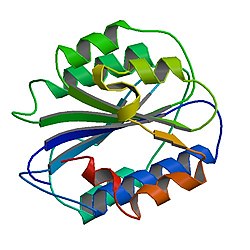Mammalian protein involved in blood clotting
| VWF |
|---|
 |
| Available structures |
|---|
| PDB | Ortholog search: PDBe RCSB |
|---|
| List of PDB id codes |
|---|
1AO3, 1ATZ, 1AUQ, 1FE8, 1FNS, 1IJB, 1IJK, 1M10, 1OAK, 1U0N, 2ADF, 3GXB, 3HXO, 3HXQ, 3PPV, 3PPW, 3PPX, 3PPY, 3ZQK, 4DMU, 1UEX, 2MHP, 2MHQ, 4C29, 4C2A, 4C2B, 4NT5, 5BV8 |
|
|
| Identifiers |
|---|
| Aliases | VWF, F8VWD, von Willebrand factor |
|---|
| External IDs | OMIM: 613160; MGI: 98941; HomoloGene: 466; GeneCards: VWF; OMA:VWF - orthologs |
|---|
|
|
|
|
|
| Wikidata |
|
Von Willebrand factor (VWF) (German: [fɔn ˈvɪləbʁant]) is a blood glycoprotein that promotes hemostasis, specifically, platelet adhesion. It is deficient and/or defective in von Willebrand disease and is involved in many other diseases, including thrombotic thrombocytopenic purpura, Heyde's syndrome, and possibly hemolytic–uremic syndrome.[5] Increased plasma levels in many cardiovascular, neoplastic, metabolic (e.g. diabetes), and connective tissue diseases are presumed to arise from adverse changes to the endothelium, and may predict an increased risk of thrombosis.[6]





